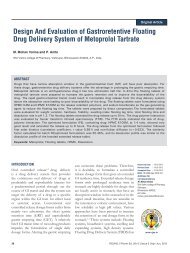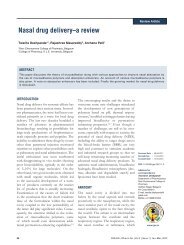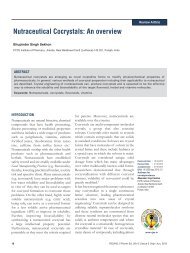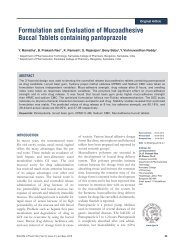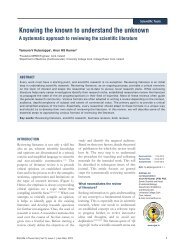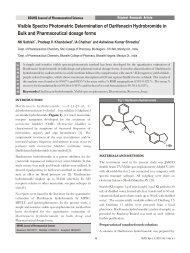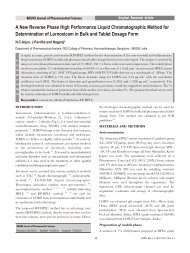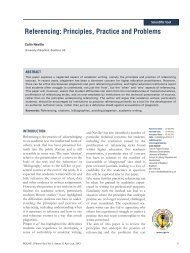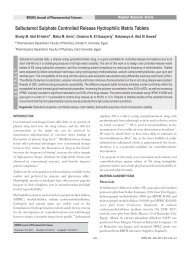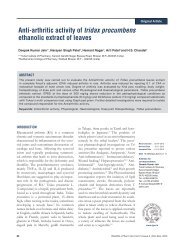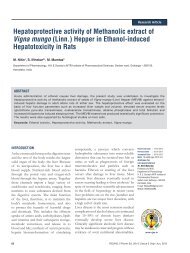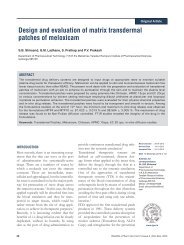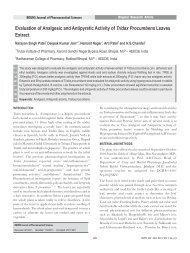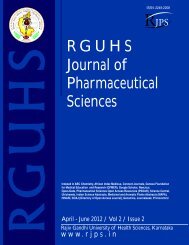Chitosan Loaded Mucoadhesive Microspheres of Gliclazide - Journal
Chitosan Loaded Mucoadhesive Microspheres of Gliclazide - Journal
Chitosan Loaded Mucoadhesive Microspheres of Gliclazide - Journal
You also want an ePaper? Increase the reach of your titles
YUMPU automatically turns print PDFs into web optimized ePapers that Google loves.
A B S T R A C T<br />
RGUHS <strong>Journal</strong> <strong>of</strong> Pharmaceutical Sciences<br />
Development and Evaluation <strong>of</strong> <strong>Mucoadhesive</strong> Buccal Films <strong>of</strong> Nebivolol<br />
Bushetti S.S*, Mane Prashant P and Kardame S.S<br />
HKES's College <strong>of</strong> Pharmacy, M R Medical College Campus, Sedam Road, Gulbarga- 585105<br />
INTRODUCTION<br />
The buccal mucosa, along with other mucosal tissues, has<br />
been investigated as a potential site for controlled delivery <strong>of</strong><br />
macromolecular therapeutic agents, such as peptides,<br />
proteins and polysaccharides because <strong>of</strong> its accessibility and<br />
low enzymatic activity compared to the gastro-intestinal tract.<br />
Another interesting advantage is its tolerance (in comparison<br />
1<br />
with the nasal mucosa and skin) to potential sensitizers.<br />
The potential <strong>of</strong> the buccal mucosa as an alternative site for<br />
the delivery <strong>of</strong> drugs into the systemic circulation has recently<br />
received much attention. There are many reasons why the<br />
buccal mucosa might be an attractive site for the delivery <strong>of</strong><br />
therapeutic agents into the systemic circulation. Due to the<br />
direct drainage <strong>of</strong> blood from the buccal epithelium into the<br />
internal jugular vein, the first-pass metabolism in the liver and<br />
intestine may be avoided. This first-pass effect is a major<br />
reason for the poor bioavailability <strong>of</strong> some compounds when<br />
administered orally. Additionally, the mucosa lining the oral<br />
cavity is easily accessible, which ensures that a dosage form<br />
can be applied to the required site and can be removed easily<br />
2<br />
in case <strong>of</strong> emergency.<br />
The oral cavity is a moist environment; the membranes that<br />
line the oral cavity are covered with mucus which is derived<br />
mainly from minor salivary glands and are constantly bathed<br />
in saliva, an aqueous substance rich in inorganic salts, proteins<br />
and bacteria. Saliva has a variety <strong>of</strong> functions and is<br />
RGUHS <strong>Journal</strong> <strong>of</strong> Pharmaceutical Sciences<br />
Received: 28/1/2011, Modified: 21/2/2011, Accepted: 3/3/2011<br />
Original Research Article<br />
Nebivolol a third-generation cardio selective β1-blocker that is approved for the treatment <strong>of</strong> hypertension. Nebivolol undergoes<br />
extensive metabolism in the liver after its oral administration and resulting in to a very poor (approximately 10-12%) bioavailability. Oral<br />
administration <strong>of</strong> nebivolol can also cause gastrointestinal disturbance and abdominal or stomach pain etc. In order to improve the<br />
bioavailability, efficacy and to minimize the side effects associated with oral administration, mucoadhesive buccal films <strong>of</strong> nebivolol using<br />
hydroxy propyl methyl cellulose and methyl cellulose were prepared by solvent casting technique. The films <strong>of</strong> nebivolol using hydroxy<br />
propyl methyl cellulose and methyl cellulose were smooth, elegant and uniform in thickness and weight. Among the two polymers used<br />
hydroxyl propyl methyl cellulose showed an increased in-vitro residence time due to mucoadhesion nature <strong>of</strong> the hydroxyl propyl methyl<br />
cellulose. Drug content uniformity study showed uniform dispersion <strong>of</strong> the drug throughout the film in the range <strong>of</strong> 96.208±1.0705 to<br />
th<br />
98.887±0.2558 %. In- vitro drug release study showed that more than 90% <strong>of</strong> drug was released at the end <strong>of</strong> 8 hr. The release pr<strong>of</strong>ile <strong>of</strong><br />
all the formulations was subjected to various kinetic equations and the results suggested that the drug was released by diffusion<br />
mechanism following super case-II transport.<br />
Keywords: Nebivolol, Buccal films, Mucoadhesion, In vitro drug release and Diffusion.<br />
157<br />
continuously secreted into, distributed around and removed<br />
3<br />
from the oral cavity .<br />
Based on the current understanding <strong>of</strong> biochemical and<br />
physiological aspects <strong>of</strong> absorption and metabolism <strong>of</strong><br />
biotechnologically- produced drugs, they cannot be delivered<br />
effectively through the conventional oral route. Because after<br />
oral administration many drugs are subjected to presystemic<br />
clearance extensive in liver, which <strong>of</strong>ten leads to a lack <strong>of</strong><br />
significant correlation between membrane permeability,<br />
absorption, and bioavailability. Difficulties associated with<br />
parenteral delivery and poor oral availability provided the<br />
impetus for exploring alternative routes for the delivery <strong>of</strong><br />
4<br />
such drugs.<br />
Nebivolol is a third-generation β1selective β-blocker used in<br />
5<br />
the treatment <strong>of</strong> hypertension , it works by relaxing blood<br />
vessels and slowing heart rate to improve blood flow and<br />
6<br />
decrease blood pressure . Nebivolol on oral administration<br />
undergoes extensive metabolism in the liver resulting into very<br />
7<br />
poor (approximately 10- 12%) bioavailability . It can also<br />
cause gastrointestinal disturbance and abdominal or stomach<br />
pain, etc. In order to improve its bioavailability, efficacy and to<br />
minimize the side effects associated with oral administration,<br />
mucoadhesive buccal films <strong>of</strong> nebivolol using hydroxy propyl<br />
methyl cellulose and methyl cellulose were prepared by<br />
solvent casting technique in the present investigation.<br />
MATERIALS AND METHODS<br />
Nebivolol was a gift sample from Ajanta Pharma Ltd.,<br />
Mumbai. HPMC (G-236007), and MC (040801) were<br />
RJPS, Jul - Sep, 2011/ Vol 1/ Issue 2



